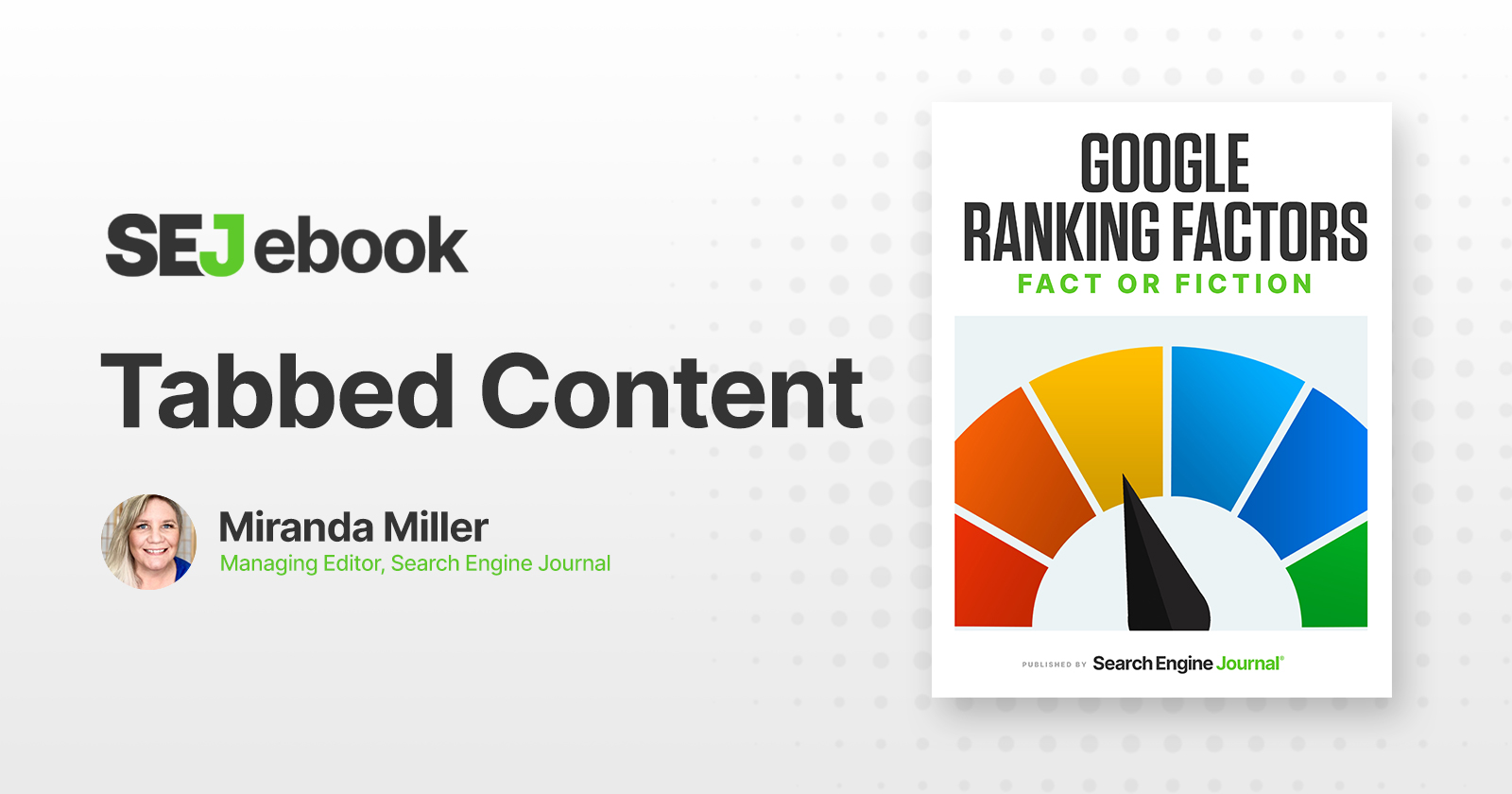SEO
Is It A Google Ranking Factor?

In-page tabs and accordions are a type of user interface (UI) control that can improve the user’s experience by splitting content into logical sections.
Page visitors are then able to switch between different views by navigating through each tab or clicking to reveal a new section of text from the accordion.
But how does this impact the SEO value of the content that’s hidden until the user actively navigates to and reveals it?
Many have questioned over the years whether Google still uses this type of hidden content in its ranking algorithm.
So let’s see.
The Claim: “Hidden” Content Is A Ranking Factor
The question here is whether Google devalues or even ignores content that is initially hidden from the user using UX/design elements.
It’s important to note that we’re not talking about hiding text in an effort to manipulate the algorithm by using CSS to position it off-screen or hiding it against the background, for example.
Tabs and accordions are used to organize page content in the same way as their namesakes from the old school world of paper filing.
On webpages, tabs are typically arranged horizontally.
The user can flip from tab to tab to reveal new content without having to load a new page each time.
And with accordions, users can click to open each one, typically closing the others as the new section opens (but not always, which can result in a very long page of text).
Tabs and accordions can be useful for:
- FAQs content.
- Video transcripts or descriptive content for accessibility.
- User reviews, which can be truncated but give users the option to “Read More.”
- Navigating through complex topics.
- To categorize types of information on a single page.
- And lots more.
The Evidence For Tabbed Content As A Ranking Factor
This is what Google’s Webmaster Guidelines has to say about content hidden in tabs:
“Make your site’s important content visible by default. Google is able to crawl HTML content hidden inside navigational elements such as tabs or expanding sections.
However, we consider this content less accessible to users, and believe that you should make your most important information visible in the default page view.”
Matt Cutts addressed the issue from a webspam perspective in a 2013 response to a viewer’s question, “How does Google treat hidden content which becomes visible when clicking a button?”
There are good usability reasons for using an accordion or tabbed structure that lets users hide and reveal content, he said.
As long as you’re not trying to be deceptive with hidden, over-optimized text, you aren’t going to trigger any spam actions.
That tells us that Google doesn’t see properly structured and formatted tabs or accordions as hidden text.
But is the content in those tabs weighted the same as page content that is always visible?
In 2014, Google’s John Mueller was asked about reports of Google, when rendering pages, ignoring content that isn’t visible to a user unless they clicked on a “click to expand” button.
Mueller said,
“…I think we’ve been doing something similar for quite a while now, where if we can recognize that the content is actually hidden then we’ll just try to discount it a little bit. We kind of see that it’s still there, but the user doesn’t see it. Therefore, it’s probably not something that’s critical for this page.”
He noted that he was speaking of both accordions and tabs, and advised that if you want content indexed, make sure it’s visible to users.
The Evidence Against Tabbed Content As A Ranking Factor
The thing is, aside from the Webmaster Guidelines excerpt above, that advice on tabbed content is pretty old.
Google’s perception of what makes a great user experience has evolved, particularly when it comes to mobile.
In 2016, Google’s Gary Illyes responded to a tweeted question asking whether the content in in-page elements such as accordions was devalued on mobile, and his response was clear:
“No, in the mobile-first world content hidden for UX should have full weight.”
Mueller more recently confirmed in a March 2020 Google Webmaster Central office hours episode that tabbed and accordion content is not devalued. When asked:
“In the mobile-first indexing world, will the hidden content behind tags and accordions still be devalued — for example, because there is a lower chance it’ll be seen by a user?”
Mueller responded:
“No. Specifically, when it comes to content on mobile pages, we do take into account anything that’s in the HTML.
So if there is something there that might be visible to users at some point, we will include that in the indexing. That’s completely normal.”
Tabbed Content As A Ranking Factor: Our Verdict

Content is a ranking factor – and you do not devalue that content by enabling users to control what content they see and when.
Tabbing the content would basically be the same as not tabbing it.
So does it ultimately matter whether that content is tabbed?
We know that, with mobile-first indexing, Google gives tabbed content the same weight as the rest of the text on the page.
Content is the key part, not the fact that it’s tabbed.
There are many ways to “hide” tabbed content – some of which make it impossible for Google to crawl it.
And if Google can’t crawl content, that content won’t be seen or help you rank.
Tabbed and accordion content, when used correctly, can also improve user experience – especially on mobile.
If you’re trying to use hidden text deceptively, that’s where you run the risk of a partial or site-wide penalty.
To be clear again, here: The key part is the deception, not the fact that the content happens to be tabbed deceptively.
As best practice, use these elements from a strictly UX perspective.
Take a look at how Google itself uses an accordion structure on its Search Console help resource page:
 Image from Search Console help, February 2022
Image from Search Console help, February 2022The accordion is used as a navigational tool to reveal FAQs.
Clicking on a question opens a separate page where the longer form answer lives.
This serves both UX and SEO objectives.
It’s simple for the user to see all broad topics at a glance and drill down into more specific questions.
They can then navigate to a more focused page and dig into the response they choose, versus having 15 or 20 somewhat disconnected answers in core body content opening up and closing back down on the main page.
Each individual answer is stronger from an SEO perspective as an authoritative response to a specific question on its own page.
Think first of how you can improve your visitor’s journey and experience with your content.
More often than not, that’s exactly what you need to do to improve your SEO, as well.
Featured Image: Robin Biong/Search Engine Journal
SEO
Executive Director Of WordPress Resigns

Josepha Haden Chomphosy, Executive Director of the WordPress Project, officially announced her resignation, ending a nine-year tenure. This comes just two weeks after Matt Mullenweg launched a controversial campaign against a managed WordPress host, which responded by filing a federal lawsuit against him and Automattic.
She posted an upbeat notice on her personal blog, reaffirming her belief in the open source community as positive economic force as well as the importance of strong opinions that are “loosely held.”
She wrote:
“This week marks my last as the Executive Director of the WordPress project. My time with WordPress has transformed me, both as a leader and an advocate. There’s still more to do in our shared quest to secure a self-sustaining future of the open source project that we all love, and my belief in our global community of contributors remains unchanged.
…I still believe that open source is an idea that can transform generations. I believe in the power of a good-hearted group of people. I believe in the importance of strong opinions, loosely held. And I believe the world will always need the more equitable opportunities that well-maintained open source can provide: access to knowledge and learning, easy-to-join peer and business networks, the amplification of unheard voices, and a chance to tap into economic opportunity for those who weren’t born into it.”
Turmoil At WordPress
The resignation comes amidst the backdrop of a conflict between WordPress co-founder Matt Mullenweg and the managed WordPress web host WP Engine, which has brought unprecedented turmoil within the WordPress community, including a federal lawsuit filed by WP Engine accusing Mullenweg of attempted extortion.
Resignation News Was Leaked
The news about the resignation was leaked on October 2nd by the founder of the WordPress news site WP Tavern (now owned by Matt Mullenweg), who tweeted that he had spoken with Josepha that evening, who announced her resignation.
He posted:
“I spoke with Josepha tonight. I can confirm that she’s no longer at Automattic.
She’s working on a statement for the community. She’s in good spirits despite the turmoil.”
Screenshot Of Deleted Tweet
Josepha tweeted the following response the next day:
“Ok, this is not how I expected that news to come to y’all. I apologize that this is the first many of you heard of it. Please don’t speculate about anything.”
Rocky Period For WordPress
While her resignation was somewhat of an open secret it’s still a significant event because of recent events at WordPress, including the resignations of 8.4% of Automattic employees as a result of an offer of a generous severance package to all employees who no longer wished to work there.
Read the official announcement:
Featured Image by Shutterstock/Wirestock Creators
SEO
8% Of Automattic Employees Choose To Resign

WordPress co-founder and Automattic CEO announced today that he offered Automattic employees the chance to resign with a severance pay and a total of 8.4 percent. Mullenweg offered $30,000 or six months of salary, whichever one is higher, with a total of 159 people taking his offer.
Reactions Of Automattic Employees
Given the recent controversies created by Mullenweg, one might be tempted to view the walkout as a vote of no-confidence in Mullenweg. But that would be a mistake because some of the employees announcing their resignations either praised Mullenweg or simply announced their resignation while many others tweeted how happy they are to stay at Automattic.
One former employee tweeted that he was sad about recent developments but also praised Mullenweg and Automattic as an employer.
He shared:
“Today was my last day at Automattic. I spent the last 2 years building large scale ML and generative AI infra and products, and a lot of time on robotics at night and on weekends.
I’m going to spend the next month taking a break, getting married, and visiting family in Australia.
I have some really fun ideas of things to build that I’ve been storing up for a while. Now I get to build them. Get in touch if you’d like to build AI products together.”
Another former employee, Naoko Takano, is a 14 year employee, an organizer of WordCamp conferences in Asia, a full-time WordPress contributor and Open Source Project Manager at Automattic announced on X (formerly Twitter) that today was her last day at Automattic with no additional comment.
She tweeted:
“Today was my last day at Automattic.
I’m actively exploring new career opportunities. If you know of any positions that align with my skills and experience!”
Naoko’s role at at WordPress was working with the global WordPress community to improve contributor experiences through the Five for the Future and Mentorship programs. Five for the Future is an important WordPress program that encourages organizations to donate 5% of their resources back into WordPress. Five for the Future is one of the issues Mullenweg had against WP Engine, asserting that they didn’t donate enough back into the community.
Mullenweg himself was bittersweet to see those employees go, writing in a blog post:
“It was an emotional roller coaster of a week. The day you hire someone you aren’t expecting them to resign or be fired, you’re hoping for a long and mutually beneficial relationship. Every resignation stings a bit.
However now, I feel much lighter. I’m grateful and thankful for all the people who took the offer, and even more excited to work with those who turned down $126M to stay. As the kids say, LFG!”
Read the entire announcement on Mullenweg’s blog:
Featured Image by Shutterstock/sdx15
SEO
YouTube Extends Shorts To 3 Minutes, Adds New Features

YouTube expands Shorts to 3 minutes, adds templates, AI tools, and the option to show fewer Shorts on the homepage.
- YouTube Shorts will allow 3-minute videos.
- New features include templates, enhanced remixing, and AI-generated video backgrounds.
- YouTube is adding a Shorts trends page and comment previews.
-

 WORDPRESS3 days ago
WORDPRESS3 days agoWordPress biz Automattic details WP Engine deal demands • The Register
-
SEARCHENGINES5 days ago
Daily Search Forum Recap: September 30, 2024
-

 SEARCHENGINES6 days ago
SEARCHENGINES6 days agoGoogle Volatility With Gains & Losses, Updated Web Spam Policies, Cache Gone & More Search News
-

 SEO7 days ago
SEO7 days ago6 Things You Can Do to Compete With Big Sites
-
SEARCHENGINES4 days ago
Daily Search Forum Recap: October 1, 2024
-

 SEO6 days ago
SEO6 days agoAn In-Depth Guide For Businesses
-

 AFFILIATE MARKETING6 days ago
AFFILIATE MARKETING6 days agoThis Minimalist Lamp Lets You Pick From 16 Million+ Lighting Colors for Maximum Productivity
-

 AFFILIATE MARKETING6 days ago
AFFILIATE MARKETING6 days agoNvidia CEO Jensen Huang Praises Nuclear Energy to Power AI















You must be logged in to post a comment Login